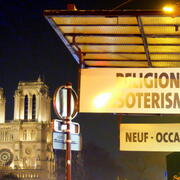
Last month I visited Paris over spring break, partly on school business and partly to visit some of the sights in one of my favorite cities. I made a pilgrimage to the Montparnasse cemetery to visit its beautiful Jewish section, and the graves of intellectuals and writers like Emile Durkheim and Samuel Beckett, Jean-Paul Sartre and Simone de Beauvoir. I visited the hotel where James Joyce reputedly wrote Finnegan’s Wake and wandered through the remarkable art and artifacts of the Islamic section of the Louvre.
Part of the experience for me, as a very amateur photographer, is to record these visits as an aid to an unreliable memory. One photograph I took was of a Paris night scene. In the foreground is a neon-lit sign with the words “religions esoterisme,” and in the background there are the gothic towers of Notre Dame cathedral, floodlit and majestic against the night sky.
I thought of the picture as a contrast between the esoteric and novel characteristics of religion on the one hand, and the ancient and public dimensions of religious traditions on the other; but I also saw the photo as a kind of whimsical irony about French religion and secularity, which I have written about in more serious academic ways. What made the irony work for me, then, was the sense that Notre Dame stood there, impervious, majestic and beautiful, well able to withstand the quirky sense of humor of a condescending tourist.
This week I saw Notre Dame differently. The raging fire, the water-dripped melancholy, and the haunting hymn-singing of stunned Parisians made me revisit my quirky photograph.
I have sat and reflected in Notre Dame cathedral several times before, but I never really took seriously its symbolic and actual importance, not only for French Catholics, but also for all of us, as a connector between the deep past and the present, and between the faithful and the not-so-devout or even avidly secular. The images of the collapsing tower and the luminous golden cross amid the charred debris will be with us for a very long time.
It is a truism to say that we never fully appreciate the people and the places we love until they are no longer with us. Fortunately for the Catholics of Paris and communities of faith of all kinds around the world, Notre Dame is sadly diminished, but not broken beyond repair. In Victor Hugo’s novel, The Hunchback of Notre Dame, the main character reflects that in the face of ridicule and worse the cathedral was enough for him because its marble figures “looked at him with only tranquility and benevolence.” More than anything, a charred Notre Dame now needs our benevolence to complete its resurrection.
David N. Hempton
Dean of the Faculty of Divinity
Alonzo L. McDonald Family Professor of Evangelical Theological Studies
John Lord O'Brian Professor of Divinity